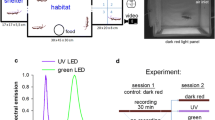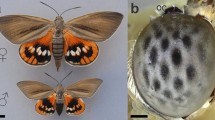Summary
-
1.
The spectral sensitivity in the wavelength range of 340–750 nm was determined by both a behavioral approach based on spontaneous positive phototaxis and the electroretinogram (ERG).
-
2.
Concerning phototaxis the camel tick,Hyalomma dromedarii, showed two sensitivity maxima, one in the UV range (ca. 380 nm) and another in the blue-green range (ca. 500 nm). At higher intensities the relative sensitivity was more pronounced in the UV and at lower intensities more pronounced in the blue-green (reverse Purkinje shift). In the tropical bont tick,Amblyomma variegatum, there was a single sensitivity maximum in the blue range (ca. 480 nm).
-
3.
In the ERG there was a maximum in the blue range (ca. 470 nm) in both species and a weak secondary maximum in the UV inHyalomma.
-
4.
The absolute sensitivity was very high. The threshold irradiance of phototaxis was as low as 5.2×106 photons·s−1·cm−2 inHyalomma and 5.2×108 photons·s−1·cm−2 inAmblyomma.
-
5.
When the eyes ofHyalomma were covered, the threshold irradiance was still very low, namely 5.2×108 photons·s−1·cm−2, indicating high absolute sensitivity of the extraretinal photoreceptors.
-
6.
The visual field of the eyes was determined by ERG measurements. In both species the optical axis of each eye, i.e., the center of the visual field, was directed somewhat to the side and above the horizon. InHyalomma this direction was 35° to the long axis of the animal and 30° above the horizon for natural body posture during walking. InAmblyomma the corresponding angles were 39° and 33°, respectively. The size of the field (at 50% sensitivity) inHyalomma was relatively small, namely 14° in the horizontal and 25° in the vertical direction, compared with that ofAmblyomma with 43° and 49°, respectively.
-
7.
This is the first demonstration in ticks of spectral and absolute sensitivity by the behavioral approach and of the visual field by ERG. The results suggest that tick eyes possess features of both spider eyes and insect ocelli.
Similar content being viewed by others
References
Balashov YS (1968) Bloodsucking ticks (Ixodoidea) — vectors of diseases of man and animals [in Russian]. Akad Nauk SSSR Zool Inst, Leningrad, English translation 500 (T500) by Strekalovsky OG (1972), Departement of Medical Zoology, United States Naval Medical Research Unit No. 3, Cairo (Egypt); Misc Publ Entomol Soc Am 8:161–376
Batschelet E (1981) Circular statistics in biology. Academic Press, London New York Toronto
Belozerov VN (1982) Diapause and biological rhythms in ticks. In: Obenchain FD, Galun R (eds) Physiology of ticks. Pergamon Press, Oxford New York Toronto, pp 469–500
Bernadskaya ZM (1938) Study ofHyalomma tick biology in sandy desert conditions [in Russian, English summary]. Tr Uzb Nauchho-Issled Vet Opyt Stn Narkom UzSSR 10:18–35
Binnington KC (1972) The distribution and morphology of probable photoreceptors in eight species of ticks (Ixodoidea). Z Parasitenkd 40:321–332
Brady J (1987) The sunset activity of tsetse flies: a light threshold study onGlossina morsitans. Physiol Entomol 12:363–372
Camin J (1953) Observations on the life history and sensory behavior of the snake mite,Ophionyssus natricis (Gervais) (Acarina: Macronyssidae). Acad Sci Spec Publ 10, Chicago
Carroll JF, Pickens LG (1987) Spectral sensitivity to light of two species of ticks (Acarina: Ixodidae). Ann Entomol Soc Am 80:256–262
Chappell RL, DeVoe RD (1975) Action spectra and chromatic mechanisms of cells in the median ocelli of dragonflies. J Gen Physiol 65:399–419
DeVoe RD (1972) Dual sensitivities of cells in wolf spider eyes at ultraviolet and visible wavelengths of light. J Gen Physiol 59:247–269
El-Ziady S (1958) The behavior ofOrnithodoros erraticus (Lucas 1849), small form (Ixodoidea, Argasidae), towards certain environmental factors. Ann Entomol Soc Am 51:317–336
FAO (1984) Ticks and tick-borne disease control. A practical field manual, vol I, Tick Control. Food and Agriculture Organization of the United Nations, Rome
Forster L (1985) Target discrimination in jumping spiders (Araneae: Salticidae). In: Barth FG (ed) Neurobiology of arachnids. Springer, Berlin Heidelberg New York, pp 203–229
Frank KD, Zimmerman WF (1969) Action spectra for phase shifts of a circadian rhythm inDrosophila. Science 163:688–689
Geiser FX (1985) Elektrophysiologische Charakterisierung der Ocellen vonApis mellifera undCataglyphis bicolor. PhD thesis, University of Zürich (Switzerland)
George JE (1963) Responses ofHemaphysalis leporispalustris to light. In: Naegele JA (ed) Advances in acarology, vol I. Comstock Publ Assoc, Ithaca New York, pp 425–430
Goldsmid JM (1967) Observations on the behaviour of the blue tick,Boophilus decoloratus (Koch) (Acarina: Ixodidae). J. Entomol Soc South Afr 29:74–89
Hindle E, Merriman G (1912) The sensory perception ofArgas persicus (Oken). Parasitology Cambridge 5:203–216
Hoogstraal H (1956) African Ixodoidea. I. Ticks of the Sudan (with special reference to Equatoria Province and with preliminary reviews of the generaBoophilus, Margaropus, andHyalomma). Dep Navy Bur Med Surg, Washington DC
Howell FG (1976) Influence of the daily light cycle on the behavior ofArgas cooleyi (Acarina: Argasidae). J Med Entomol Honolulu 13:99–106
Kaltenrieder M, Labhart T, Hess E (1988) Spectral sensitivity and visual field of two tick species (Hyalomma dromedarii andAmblyomma variegatum). (abstract) In: Elsner N, Barth FG (eds) Sense organs; Proc 16th Göttingen Neurobiol Conf. Thieme, Stuttgart New York, No. 230
Koch B, Kraiss-Gothe A, Gothe R (1988) Zur Reaktivität vonArgas (Persicargas) walkerae auf Lichtreize (abstract) In: 13. Tagung der Deutschen Gesellschaft für Parasitologie e.V.; 22.–25.3.1988 Neuchâtel (Switzerland), No. 7
Kuchling H (1986) Taschenbuch der Physik. Harri Deutsch, Thun Frankfurt
Labhart T (1980) Specialized photoreceptors at the dorsal rim of the honeybee's compound eye: Polarizational and angular sensitivity. J Comp Physiol 141:19–30
Land MF (1969) Movements of the retinae of jumping spiders (Salticidae: Dendryphantinae) in response to visual stimuli. J Exp Biol 51:471–493
Land MF (1981) Optics and vision in invertebrates. In: Autrum H (ed) Vision in invertebrates (Handbook of sensory physiology, vol VII/6B). Springer, Berlin Heidelberg New York, pp 471–592
Land MF (1985) The morphology and optics of spider eyes. In: Barth FG (ed) Neurobiology of arachnids. Springer, Berlin Heidelberg New York, pp 53–78
Lees AD (1981) Action spectra for the photoperiodic control of polymorphism in the aphidMegoura viciae. J Insect Physiol 27:761–771
Leonovich SA (1986) The orientational behaviour of the tickHyalomma asiaticum in a desert [in Russian, English summary]. Parasitologiya 20:431–439
McEnroe WD, Dronka K (1966) Color vision in the adult female two-spotted spider mite. Science 154:782–784
McEnroe WD, McEnroe MA (1973) Questing behavior in the adult American dog tickDermacentor variabilis Say. (Acarina: Ixodidae). Acarologia 15:37–42
McFarland WN, Munz FW (1977) The visible spectrum during twilight and its implications to vision. In: Evans GC, Bainbridge R, Rackham O (eds) Light as an ecological factor, vol II. Blackwell Sci Publ, Oxford London Edinburgh Melbourne, pp 249–270
Menzel R, Greggers U (1985) Natural phototaxis and its relationship to colour vision in honeybees. J Comp Physiol A 157:311–321
Mironov VS (1939) On the behaviour of the Siberian forest tickIxodes persulcatus Schulze [in Russian, English summary]. Med Parazitol Parazit Bolezni 8:123–136
Mobbs PG, Guy RG, Goodman LJ, Chappell RL (1981) Relative spectral sensitivity and reverse Purkinje shift in identified L neurons of the ocellar retina. J Comp Physiol 144:91–97
Morel PC (1969) Contribution à la connaissance de la distribution des tiques (Acariens, Ixodidae et Amblyommidae) en Afrique éthiopienne continentale. PhD thesis, University of Paris (France)
Naegele JA, McEnroe WD, Soans AB (1966) Spectral sensitivity and orientation response of the two-spotted spider mite,Tetranychus urticae Koch, from 350 mμ to 700 mμ. J Insect Physiol 12:1187–1195
Panfilova IM (1976) Reaction of ixodid ticksIxodes persulcatus, Dermacentor silvarum andHaemaphysalis concinna to light [in Russian, English summary]. Zool Zh 55:371–377
Peaslee AG, Wilson G (1989) Spectral sensitivity in jumping spiders (Araneae, Salticidae). J Comp Physiol A 164:359–363
Sachs L (1984) Angewandte Statistik. Springer, Berlin Heidelberg New York
Seliger HH, McElroy WD (1965) Light: physical and biological action. Academic Press, New York London
Shoukrey NM, Sweatman GK (1984) The peripheral nervous system of the tickArgas arboreus. Can J Zool 62:893–926
Stange G (1981) The ocellar component of flight equilibrium control in dragonflies. J Comp Physiol 141:335–347
Tevini M, Häder DP (1985) Allgemeine Photobiologie. Thieme, Stuttgart New York
Totze R (1933) Beiträge zur Sinnesphysiologie der Zecken. Z Vergl Physiol 19:110–161
Truman JW (1976) Extraretinal photoreception in insects. Photochem Photobiol 23:215–225
Wilson M (1978) The functional organisation of locust ocelli. J Comp Physiol 124:297–316
Zwicky KT (1970) Behavioural aspects of the extraocular light sense ofUrodacus, a scorpion. Experientia 26:747–748
Author information
Authors and Affiliations
Rights and permissions
About this article
Cite this article
Kaltenrieder, M., Labhart, T. & Hess, E. Spectral sensitivity, absolute threshold, and visual field of two tick species,Hyalomma dromedarii andAmblyomma variegatum . J. Comp. Physiol. 165, 155–164 (1989). https://doi.org/10.1007/BF00619190
Accepted:
Issue Date:
DOI: https://doi.org/10.1007/BF00619190




